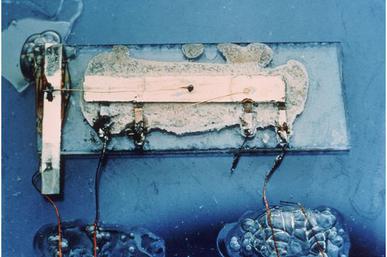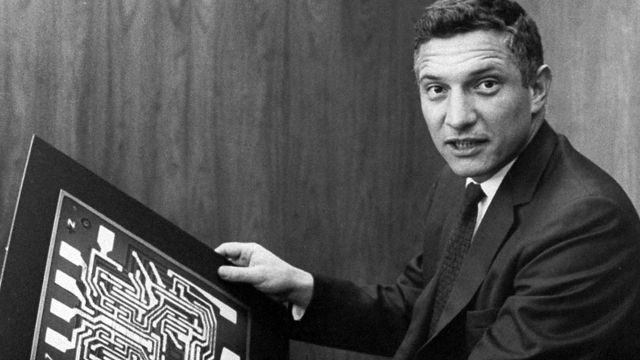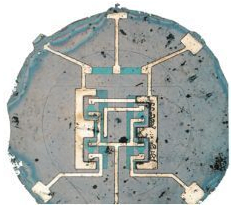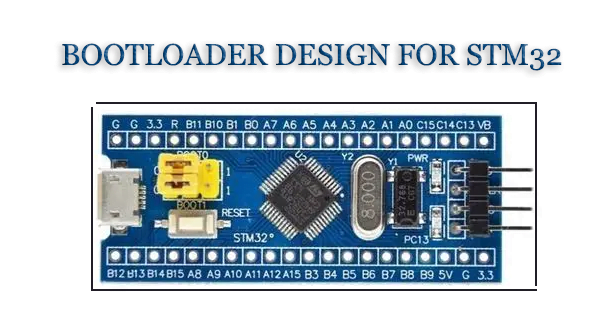Introduce to integrated circuits
The integrated circuit, also know as IC or microchip, is one of the great inventions of the 21st century. Almost all electronic products we use now contain integrated chips. So, do you know who is the real inventor of the IC?
The Inventor of integrated circuits

Overview of Jack Kilby
- In 1923, Kilby was born on in Missouri, USA.
- In 1947, Kilby graduated from the University of Illinois at Urbana-Champaign.
- In 1958, Kilby joined Texas Instruments Semiconductor Corporation.
- In 1958, Kilby invented the first integrated circuit in human history.
- In 2000, Kilby was awarded the Nobel Prize in Physics for the invention of the integrated circuit.
- In 2005, Kilby died of cancer in Dallas, Texas, at the age of 81.
The First Germanium IC - 1958
As mentioned above, Kilby joined Texas Instruments Semiconductor in 1958.
At that time, Texas Instruments and the U.S. Communications Corps were working together on a project called the Micromodule Initiative (Micromodule). The research goal of this project is to unify the size and shape of PCB electronic components such as transistors, resistors, and capacitors, so as to standardize the interconnection process, reduce circuit space, and reduce the difficulty and error rate of soldering.
Kilby didn’t think the idea of a micromodule project made sense, so he started working on a better solution.
At first, Kilby devised a replacement. As a result, after a cost analysis, it was found that the cost was too high to be mass-produced. So, he got into a research dilemma.
In August 1958, the situation took a turn for the better. Inspired by renowned scientist Geoffrey Dummer of the Royal Radar Institute, Kilby discovered that extremely small microcircuits consisting of many devices could be fabricated on a single chip. In other words, different electronic devices such as resistors, capacitors, diodes, and transistors can be fabricated on silicon chips and connected with thin wires.
This amazing idea made him feel very excited. That day, he recorded his thoughts in detail in his notebook, and even conceived a complete circuit process, writing a full five pages.
Immediately after the holidays, Kilby reported his idea to his direct leader, Willis Adcock (then director of Texas Instruments development). He proposed that he could make a trigger circuit for verification.
Willis Adcock’s first reaction was that the plan was a bit cumbersome and unreliable. However, after much deliberation, he reluctantly agreed to Kilby’s suggestion.
So Kilby began to implement his plan. Initially, Kilby planned to use “silicon” as a substrate to make circuits. In August 1958, he made junction transistors, resistors, and capacitors out of silicon (Si), but there was no way to integrate them. In September 1958, he went on to make an integrated circuit out of germanium (Ge) that was only 7/16 inch by 1/16 inch in size. The circuit is a single transistor oscillator with RC feedback, and the whole thing is glued to the glass slide and looks very rough. The components of the circuit are connected by messy thin wires.

Witnessed by colleagues, Kilby connected ten volts to the input and the oscilloscope to the output. At the moment after connection, an oscillating waveform with a frequency of 1.2 MHz and an amplitude of 0.2 volts appeared on the oscilloscope.
Kilby succeeded, and he created the world’s first integrated circuit made of a single material. The function of this device is very simple, and that is to generate a sine wave.
Interestingly, the first chip used germanium instead of silicon. At first, the industry decided that it was simply not worth it. Only the US military is interested in this concept. He himself said: “At the time, it was just a topic of entertainment at tech conferences. But fortunately, the US military supported it.
On February 6, 1959, Texas Instruments and Kilby filed a patent application with the United States Patent Office. In the document, Kilby describes his new device as “a semiconductor material… In which all components of the electronic circuit are fully integrated”.
On March 6, 1959, the American Society of Radio Engineers (later IEEE) held its annual meeting in New York. Texas Instruments held a high-profile press conference at the prestigious Waldorf Astoria Hotel to officially present Kilby’s invention.
Mark Shepherd, then head of Texas Instruments’ semiconductor division (later president of Texas Instruments), said at a news conference: “This is the most important invention since Texas Instruments announced its entry into the transistor market.
The First Silicon IC - 1959
At the same time that Kilby invented the integrated circuit, another man also made a breakthrough in the IC field. This person is Robert Norton Noyce of Fairchild Semiconductor. He was also one of the later founders of Intel.
This process is to add a layer of silicon oxide to the silicon wafer as an insulating layer. Then, holes are punched in this layer of insulating silica, and devices made of silicon diffusion technology are connected to the aluminum film.
The birth of planar technology enabled Fairchild to manufacture high-performance silicon transistors of extremely small size and made it possible to connect devices in integrated circuits.


On January 23, 1959, Noyce wrote in his working notes: “Fabricating various devices on the same silicon wafer and joining them together using a planar process can produce multifunctional electronic circuits.” This technology can reduce the size, weight, and cost of circuits.
Noyce was shocked that Texas Instruments announced Kilby’s invention. Noyce regretted that he wasn’t moving fast enough. On the other hand, he found that Kilby’s invention was actually deeply flawed.
Kilby’s integrated circuits were connected by flying wires, which could not be mass-produced at all and lacked practical value.
Noyce’s idea is to make negative plates from all the circuits and individual components of an electronic device, and then engrave them on silicon wafers. Once the silicon wafer is carved out, it is all the circuitry that can be used directly to assemble the product. In addition, the method of metal evaporative deposition can replace thermal welding wire, completely eliminating flying wire.
On July 30, 1959, Noyce applied for a patent based on his idea: “Semiconductor Devices – Wire Structure”.
Commercial Use of ICs
In March 1960, Texas Instruments officially launched the world’s first commercial integrated circuit product, the 502 silicon bistable multiresonant binary flip-flop, based on Jack Kilby’s design, with a sales price of $450. This is the first commercial chip developed by TI. The internal structure of the chip is shown in the figure below:

The following figure is a schematic diagram of this. It can be seen that the structure of this chip is very simple, including two transistors, four diodes, six resistors and two capacitors.

In 1961, Fairchild Semiconductor released the first commercial integrated circuit. Since then, all computers have used integrated chips instead of discrete transistor circuits.
After the birth of integrated circuits, they were first used in the military field (that was the most sensitive period of the Cold War). In 1961, the US Air Force first used integrated circuits made of silicon wafers, and in 1962 they were installed in the Zouave ICBM.
The success of military applications has led to the expansion of the civilian market. In 1964, Zenith used integrated circuits in hearing aids, which was the first time that integrated circuits were used in the civilian field. Since then, the cost of integrated circuits has gradually decreased, the process has been continuously improved, and it has gradually been accepted by the industry.
In 1967, Kilby’s team successfully completed the development of a new miniature calculator, the world’s first electronic handheld calculator, the Pocketronic.
In 1970, Intel introduced the world’s first DRAM (Dynamic Random Access Memory) integrated circuit 1103.
In 1971, Intel introduced the world’s first programmable computing chip including a computing unit and a controller – Intel 4004. With 2300 transistors, the Intel 4004 was the world’s first microprocessor. Its birth kicked off the age of microcomputers.
Patent Dispute between Kilby and Noyce
To be honest, Noyce’s invention is closer to the integrated circuit in the modern sense. Neuss’s design is based on a silicon substrate planar process, while Kilby’s design is based on a germanium substrate diffusion process. Relying on Fairchild’s silicon technology advantages, Neuss’s circuit is indeed more advanced than Kilby’s.
However, Kilby’s hybrid integrated circuits already have the characteristics of integrated circuits and were used earlier.
As a result, Kilby’s Texas Instruments and Noyce’s Fairchild Semiconductor launched a fierce patent war.
Of the lawsuit, Kilby said: “No one would suspect that I was the first to make integrated circuits. Dr. Noyce was the first to do what I wanted to do – use evaporated metal to make wires between devices. Dr. Noyce’s approach is very different from what I did. He said he sympathized with me as a co-inventor, but I didn’t think so.
U.S. Federal Court Award the ICs Inventer
In 1966, the court finally awarded Kilby the invention of integrated circuits (hybrid integrated circuits), along with the invention rights of the integrated circuit packaging and manufacturing process that is now popular today Granted to Noyce.
Kilby is known as “the inventor of the first integrated circuit,” while Noyce was the one who “came up with the theory of integrated circuits suitable for industrial production.”
That same year, Texas Instruments and Fairchild entered into a cross-licensing agreement to share integrated circuit patents.
In 1969, a U.S. federal court ruled that the integrated circuit patents applied for by the two were parallel independent inventions.
In total, Jack Kilby has applied for more than sixty invention patents. He was awarded the American Medal of Science in 1970.
Robert Noyce, whose invention holds more than 16 patents, founded Intel Semiconductor, which later made the first microprocessor.








